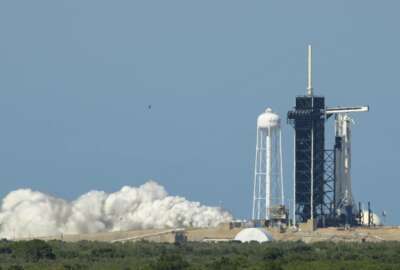
NASA launches new contracting arrangement
That'll be one small step in the history of space exploration, but a giant leap for NASA.
I’m excited about NASA’s launch of two astronauts scheduled for tomorrow. I say “scheduled” because you never know. Deputy NASA Administrator Jim Morhard and I were sharing memories of having watched launches on television in the 1960s on black-and-white television sets. Sometimes blastoffs, as they were occasionally called, were delayed by one glitch or another, often weather.
The long-time federal observer in me is impressed that NASA has reached this level of reliance on private engineering and construction. The boy in me retains the thrill of tremendous columns of fire and smoke in the blastoff.
NASA people are beaming at having gained back the capability of launching humans into low earth orbit once again, having temporarily ceded it to Russia since 2011.
Higher resolution aside, the launch will look similar to those of the Mercury era. Two men in helmeted suits lying in a capsule atop a rocket that’s hundreds of feet tall. Inside the Dragon crew capsule, touch screens have superseded the astonishing rows of buttons on the old time capsules. In the NASA home page photo you can spot an upside-down iPad on what looks like a tray table. Astronaut Robert Behnken is wearing an analog watch, though.
But unlike the Atlas, Titan and Saturn rockets of yesteryear, title to tomorrow’s vehicle is held by a private company, SpaceX. The company — with heavy financial help from NASA — developed everything from the dome-topped capsule to the launch pad. I’m sure rocket engine and other technologies have evolved a great deal since 2011, but it’s the contracting arrangement that’s the most distinctive feature of what NASA calls Launch America.
Tomorrow won’t mark SpaceX’s first rideo. It has a history. It’s been putting cargo in the Space Station and other companies’ satellites into space for several years. At its web site you can find all of the specifications for your satellite, should you wish to buy a spot on a launch. The privately held company, of which Elon Musk owns 54 percent, dates back 18 years to capitalize on what most people connected to the space industry realized would be a burgeoning private space market.
But tomorrow’s launch will be its first with people aboard. The requirements for that — if you want the people to live and return safely — are vastly more exacting than those for inanimate cargo. Every participant has a lot at stake.
Also at stake is continued U.S. access to the Space Station. As late as this past January the Government Accountability Office stated, “NASA will have fewer astronauts on the ISS in 2020 unless the Boeing and SpaceX spacecraft are ready to fly missions, but significant work remains for both. NASA has few back-up options if delays continue and will have only one astronaut on the U.S. side by April 2020. Most of this astronaut’s time will be spent on maintenance activities rather than on research and development.
Boeing is the SpaceX rival in the effort to send people to low earth orbit. Its last test launch didn’t go well. NASA engineers concluded it could have blown up. At this point it doesn’t appear to be a viable backup to SpaceX. Therefore the competitive market NASA envisions for this activity hasn’t yet matured.
Beyond that, NASA has a long way to go with its own design-build project for a big rocket and the planned 2024 return to the moon.
That’s all to be debated, tested, costed out, defended. But tomorrow, at least, let’s hope the agency can enjoy a shining moment when a new approach can perhaps become the first step in a return to space capability independence.
Copyright © 2025 Federal News Network. All rights reserved. This website is not intended for users located within the European Economic Area.
Tom Temin is host of the Federal Drive and has been providing insight on federal technology and management issues for more than 30 years.
Follow @tteminWFED
Related Stories






